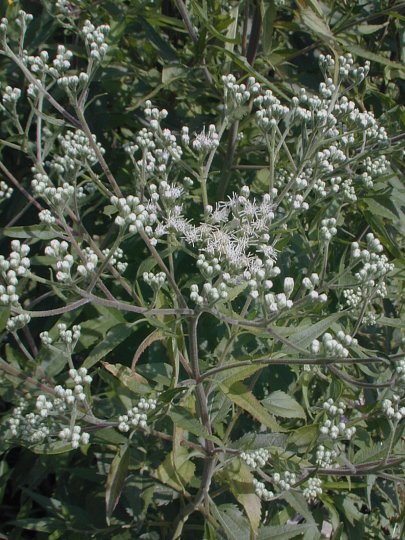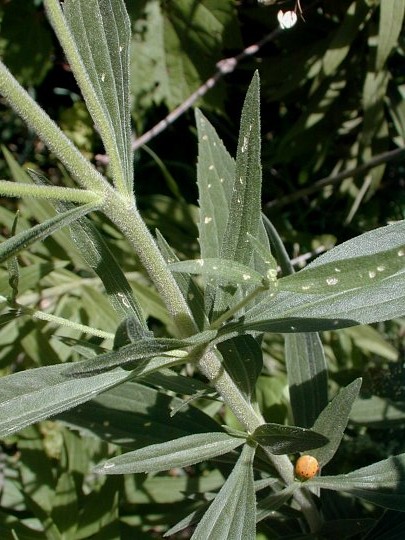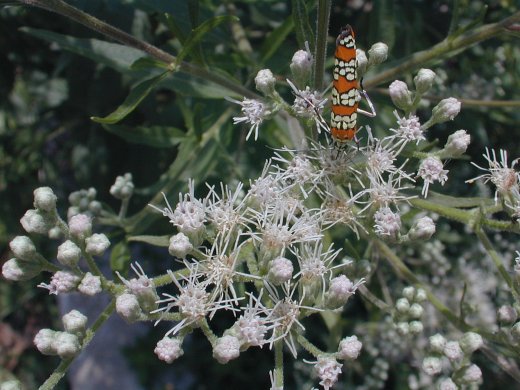Description: This perennial plant is 3-4' tall and unbranched, except for the upper flowering stems. The stems are covered with white hairs. The opposite leaves are up to 5" long and 1" across, occasionally with small teeth along the margins. They are usually dark green, lanceolate to narrowly ovate, and pubescent. There are three conspicuous veins that run along the length of each leaf. The rather flat inflorescence consists of numerous heads of small white flowers and their buds. These flowers are dull white and individually only 1/8" (3 mm.) across. There is little or no floral scent. The blooming period occurs from late summer to early fall, and lasts about 1-1½ months. The achenes develop small tufts of white or light brown hair; they are dispersed by the wind. This plant may spread vegetatively through rhizomes.

Cultivation:
The
preference is full or partial sun, and mesic to dry conditions. The
soil can contain significant amounts of loam, clay, or gravel; soil
with a high pH is tolerated. Drought tolerance is good, although the
plant may wilt. Tall Boneset is very easy to grow, and competes well
against other plants. It is usually not affected by foliar disease.
Range & Habitat:
The native Tall Boneset occurs in most of Illinois, except some
southern counties
(see Distribution
Map). It is a common plant. Habitats include mesic to
slightly dry black soil prairies, clay prairies, gravel prairies,
savannas, thickets, openings in upland forests, dry banks of lakes,
limestone glades, pastures and abandoned fields, fence rows, vacant
lots, and areas along railroads. This plant favors disturbed areas,
where it may form large colonies.

Faunal Associations: The nectar of the flowers attracts many kinds of insects, including long-tongued bees, short-tongued bees, wasps, flies, small butterflies, skippers, beetles, and plant bugs. Among these, wasps and flies are particularly common visitors. The wasp visitors include Paper wasps, Thread-Waisted wasps, bee wolves (Philanthus spp.), Scoliid wasps, Larrine wasps, Sand wasps, Spider wasps, and others. Fly visitors include Syrphid flies, bee flies, Tachinid flies, Muscid flies, and others. The caterpillars of several moths feed on various parts of Tall Boneset and closely related plants, including Haploa clymene (Clymene Moth), Phragmatobia lineata (Lined Ruby Tiger Moth), Carmenta bassiformis (Eupatorium Borer Moth; bores into roots), and Schinia trifascia (Three-Lined Flower Moth; eats flowers & seed capsules). Mammalian herbivores, including livestock, shun the bitter-tasting leaves of this plant; consequently, it tends to flourish in pastures.

Photographic
Location:
The photographs were taken at a flower garden along a sidewalk in
Urbana, Illinois, and in a vacant lot
near the same city.
Comments:
Tall Boneset often competes directly with Solidago canadensis
(Canada Goldenrod) in disturbed areas, although it prefers slightly
drier areas. The two plants appear similar to each other prior to
bloom, although the former has darker leaves. This plant provides some
white color to a fall landscape that is often dominated by forbs with
yellow flowers and the brown color of dried-out grasses. This is the
easiest boneset to grow in dry sunny areas. Some people may mistake
this plant for a weed, which it is to some extent.